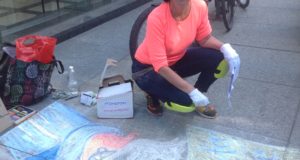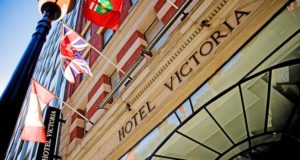Some Downtown movers and shakers have visions of turning a bland back alley into a mini pedestrian mall where people would actually stop, shop, view art and chat over coffee.
The alley is O’Keefe Lane, east of Yonge. It runs one block between Gerrard and Gould streets, sidled against the backs of Yonge St. stores and Ryerson University.
City and business reps see it one day featuring retail stores, cafés and artwork.
On Oct. 7 members of Downtown Yonge BIA, Ryerson students, staff from nearby Covenant House and officers from 52 Division took up brooms and made a clean sweep of debris that had accumulated in the alley over the summer.
“O’Keefe Lane is just another example of a laneway that needs to be treated the same as any part of the public realm, the same way as sidewalks and streets,” says Mark Garner, the BIA’s executive director. “It needs to be clean, maintained, beautified, well-lit and safe for people to use.”
The BIA has had a laneway strategy for more than three years. Garner says Yonge St. is “way too busy” with the result that people use laneways to move around more efficiently. Garner wants them cleaned monthly.
Toronto needs to look at its laneways the same way Sydney, Australia, and Seattle do, says Garner. “These should be programmable spaces, they should have retail entrances, patios, beautiful murals, art installations—similar to what Nuit Blanche does, but it should be all the time.”
He says a block of buildings abutting the laneway, on Yonge’s east side, are slated to be redeveloped as two condo towers—something that’s probably five to ten years down the road.
“With that (redevelopment) we’ll have the opportunity of internalizing all these garbage bins, all the deliveries will be inside. This will become, basically, pedestrian-only laneway space,” says Garner.
Service trucks would still be able to use the laneways—a BIA study found the laneways are used only eight to twelve per cent of the time to serve businesses—but Garner says that, as in New York City, delivery schedules could be arranged so that truck traffic is limited to specific hours.
He sees O’Keefe Lane becoming Downtown’s memory lane. “We could do a digital lighting system on the back so you could walk in a Sam the Record Man, a Cheapies, all the places that used to be on Yonge St. We could do the displays on the walls so you could come down and it would be a curated art exhibit.”
Downtown city councillor Kristyn Wong-Tam was on hand for the cleanup. She says communities have to pay more attention to their laneways. “If we can start taking pride in our laneways, meaning clean them up, it allows us to use them differently.” She says she’d like to see them feature pop-up cafés.
Wong-Tam stresses that safety, too, has to be a consideration for laneways. For O’Keefe Lane, plans include emergency call stations at both ends.
“If we can take better care of our laneways and keep eyes on (them), meaning more active use, then we can create a much more comfortable, safe and beautiful environment for everybody,” says the councillor.
Monica Jako, Ryerson’s director of strategic planning and partnerships for the faculty of arts, says safety is also on the minds of Ryerson faculty, staff and students who walk the laneway daily.
“The first and foremost we want to do is make it a safe place to be. We want it to be used by people,” says Jako.
Nov 2015
 TheBulletin.ca Journal of Downtown Toronto
TheBulletin.ca Journal of Downtown Toronto


